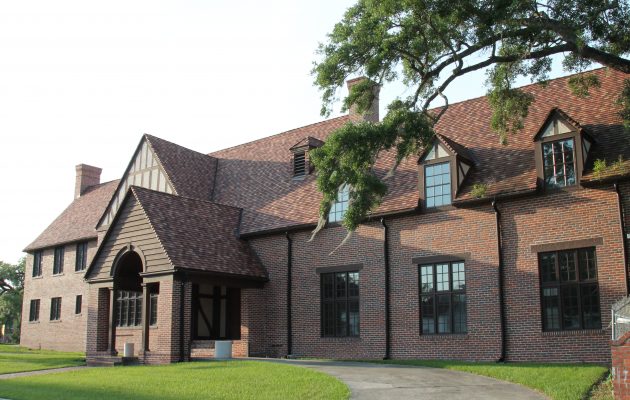Cummer board votes to demolish Woman’s Club of Jacksonville building
Posted on May 4, 2016 By Editor Articles, Neighborhood News, Top Stories

Despite every effort to save an historic Riverside building, the board of trustees of the Cummer Museum of Art & Gardens made the difficult decision in March to halt renovation of the old Woman’s Club of Jacksonville building and have it tagged for demolition.
Although the exterior is brick, the wood trusses and walls were discovered in July 2015 to be infested with the Formosan subterranean termite, which is extremely difficult – and costly – to exterminate. Despite spending the past eight months with experts in pest control, engineering, architecture and entomology, the board of trustees concluded it would take millions to remove the termites with no guarantee of success.
“We spent north of a quarter of a million dollars on mitigation, which didn’t work,” said Hope McMath, Cummer Museum executive director. “We did an in-depth, three-month lab study with experts at Louisiana State University and worked with an entomology team from the University of Florida to find a protocol to deal with Formosan termites, so we’re hovering around $300,000.”
The museum had initially raised $7 million to acquire the 13,264-square-foot building in 2005 and make renovations necessary to use it for community programming and events. It had embarked on exterior renovations and the first stage of interior work prior to the 2008 economic downturn.
The building, designed by Mellen Clark Greeley in 1927 in the style of Ninah Cummer’s estate next door, was added to the U.S. National Register of Historic Places in 1992.
Ninah Cummer had donated the land to the Women’s Club for the Tudor Revival-style building, which served as its headquarters until the Cummer Museum acquired it in 2005.
Greeley, 1880-1981, grew up in Jacksonville and supposedly lived in Riverside at 2561 Oak St. He is also responsible for the design of several residences in Riverside and Avondale, and was associate architect of the Church of the Good Shepherd.
Dr. Wayne Wood, historian and founder of Riverside Avondale Preservation, had the opportunity to tour the Women’s Club building back in the 1970s with Greeley.
“It was one of the buildings of which he was most proud; it was his favorite public building and meant a lot to him to get the commission to build it,” said Wood. “It’s certainly tragic that a building like this has to come down for this reason. No one expected it, it was a total surprise as it was a pristine building we expected to have around for a long time.”
Six weeks prior to the discovery of the termites by museum staff, the Women’s Club building had been looked at thoroughly by architects, engineers and contractors in the process of resuming renovations, but McMath said there was a chance the bugs had not been in the building very long before they were found. “We found termite tubes in the ceiling,” she said, “and immediately brought in three termite companies.”
It is unknown at this time the schedule and cost of demolition, but the funds will come from a previous fundraising campaign for the building, which included unrestricted funds.
“We’ve been so focused on trying to save the building and eradicate the termites we haven’t been able to focus on demolition,” said McMath. “But we will likely follow a protocol used in New Orleans, which is specific to disposing of wood infected with Formosan termites.”
A joint statement issued by Keith Holt, board chair for Riverside Avondale Preservation, and Adrienne Burke, RAP executive director, indicated RAP will be involved with the Cummer’s request for demolition but is taking no position on it. The Cummer Museum is not located within the Riverside Avondale Overlay, but McMath said they treat their partnership and relationship with RAP as if it were.
“We look forward to learning more about their research [on the termite infestation] and plan to coordinate with them to share information with the community,” Holt and Burke noted in their statement.
Although four oak trees on the property were also found to be infested with the aggressive termites, the museum received a clean bill of health, primarily because there is no wood in its infrastructure unlike the Women’s Club building, according to McMath.
“The Cummer was so diligent in seeking every possible remedy and sparing no expenses to find a solution. It’s regrettable, but it has to be torn down to prevent further infestation,” said Wood. “These termites are big, they’re bad, and they are numerous. This is a threat to historic buildings in Jacksonville.”
Wood said RAP has plans to host several neighborhood workshops to make people aware of the danger. He said due to the swarming pattern of the termite, a three- to five-block area around the Women’s Club and the Cummer will need to be investigated for additional nests.
McMath said UF’s research found the only way to deal with the voracious termites is through in-ground bait stations. “Their protocol is very specific about where to place them, how to monitor them,” she said. “It is informing our new practices for the whole campus.”
Eventually, the museum will rebuild on that property, but would most likely not consider constructing a replica of the Women’s Club.
“We are committed to moving forward with a space dedicated to community and educational programming,” said McMath. “It’s too early to talk about what it will look like, but we want a building that will work well with the Cummer campus and in the community, be of Cummer quality, and serve the purpose it’s meant to serve.”
By Kate A. Hallock
Resident Community News




 (No Ratings Yet)
(No Ratings Yet)




